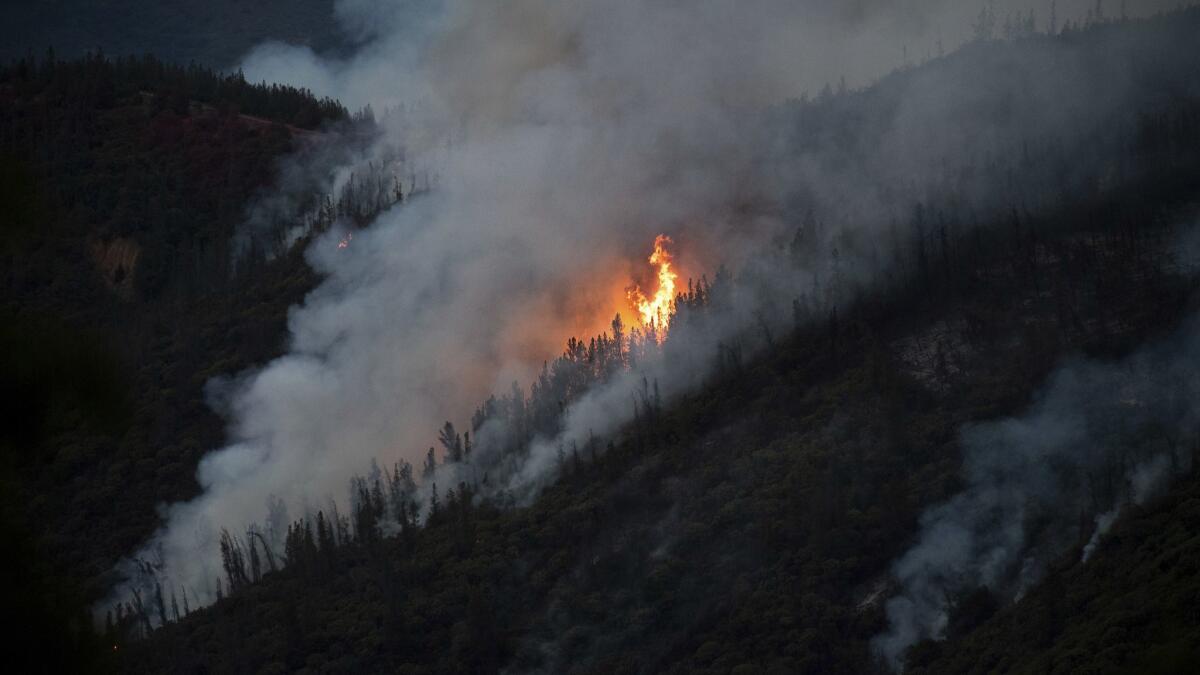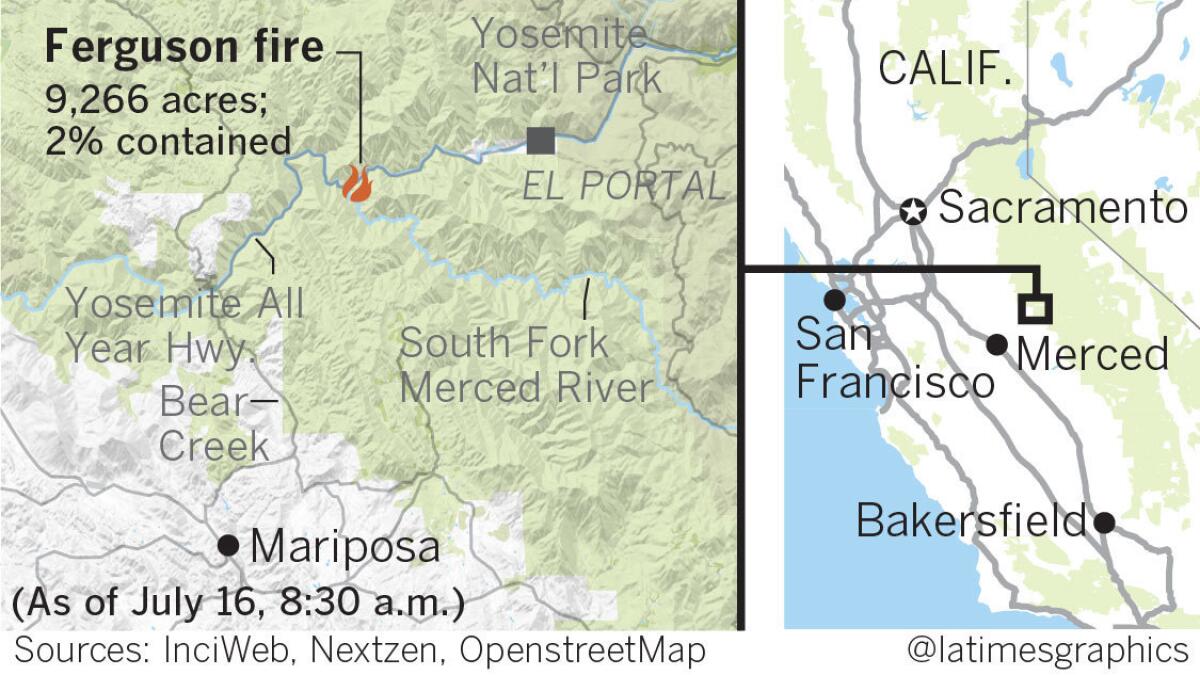Deadly wildfire near Yosemite National Park almost doubles in size to 9,300 acres

- Share via
The terrain surrounding Mariposa County’s deadly Ferguson fire is a virtual tinderbox primed for disaster, experts say.
On either side of the Merced River, south of Highway 140, hillsides are filled with trees that have been killed by five years of drought and a bark beetle infestation, according to state maps. The ground is carpeted with bone-dry pine needles.
For the record:
5:35 a.m. July 17, 2018This article states that the Detwiler fire started a few miles east of the Ferguson fire. It started to the west of the Ferguson fire.
As crews battle to keep the 9,366-acre blaze from spreading into these ready-to-burn hillsides, some worry it could unleash the destructive power of last year’s Detwiler fire, which burned for five months through dead forest and destroyed 63 homes.
“The dry needles help with ladder fuels and the burn upwards. When the needles fall, that puts fuel on the ground, pushing the fire through,” said Heather Williams, a spokeswoman with the California Department of Forestry and Fire Protection.
The Detwiler fire started a few miles east of the current Ferguson fire. It’s the last major blaze Williams could recall that ran through dead forests like the current blaze has the potential to do. That blaze burned on the edge of Mariposa and in a swath of the Sierras hard-hit by California’s sustained drought and huge bark beetle infestation. The fire burned hotter than crews had seen in years and sent smoke floating as far north as Idaho, according to reports at the time.
The Ferguson fire, which began on Saturday, was 2% contained by Monday morning.
The fire is traveling along the south fork of the Merced River, between groves of trees that have died in the last two years (about 89 million in 2016 and 2017,) according to a state tree mortality map. Since then, the trees’ leaves and needles have dried up and fallen to the ground, creating a flammable layer that has not been touched by recent fires, officials said.
The combination dead or dying fuels mixed with fire poses an amplified hazard for firefighters, Williams said.
“The biggest overall risk is that these dead trees have an increased risk of falling - themselves and their limbs falling on firefighters,” she said.
But crews may have to trek into these dangerous patches of land if it means protecting nearby homes, Williams said.
Fire officials are planning on setting up containment lines along the fire’s southern flank to prevent it from reaching the groves of dead trees, but they’ll be facing headwinds to do it, according to the National Weather Service.
As is typical for the area, the light winds blowing north and northeast around the Ferguson fire Monday morning were expected to shift at night, when they will instead begin to push the fire southwest in the direction of Midpines, meteorologist Brian Ochs said.
Thus far, the fire has not damaged any structures. More than 100 buildings were threatened and evacuations remained in place in Briceburg, Cedar Lodge and Mariposa Pines north of Bear Clover.

Facing steep, inaccessible terrain in many spots, firefighters are attacking the flames directly where they can but are otherwise focusing on setting up defenses and contingency lines where they plan to make stands against the flames.
To reduce the fire danger, Pacific Gas & Electric Co. on Sunday switched off power lines serving the area, affecting parts of Yosemite, El Portal and Foresta.
Braden Varney, a bulldozer operator with Cal Fire, died at the scene as crews battled the fire early Saturday, Cal Fire spokesman Scott McLean said.
Varney, 36, of Mariposa had served in Cal Fire’s Madera-Mariposa-Merced Unit for a decade. He left behind a wife and two young children, the agency said.
His bulldozer tumbled down a steep canyon while he was cutting vegetation to protect Jerseydale in case the fire moved in that direction, Cal Fire spokesman Jeremy Rahn said Sunday afternoon.
Varney had started at 8:30 p.m. Friday, and at some point radio contact with him was lost, Rahn said. He could not say whether the accident occurred in darkness or daylight, but he said it was not unusual for bulldozer operators to work in darkness.
“It’s common practice for the dozers to be working through the night,” Rahn said.
Varney was spotted from the air about 8 a.m. Saturday. A crew confirmed his death. But because of the inaccessible terrain, his body is not going to be recovered until Monday at the earliest.
McLean said Varney’s death is still under investigation. Varney was working on the line with teams trying to contain the fire when he was killed, McLean said. The area where firefighters were working is generally inaccessible, with rough and steep terrain.
Last year, firefighter Cory Iverson died of burns and smoke inhalation while battling the Thomas fire in Ventura County.
McLean said he couldn’t recall firefighter deaths coming so close together in California in many years.
“We’re talking very extreme fire behavior,” he said. “Everybody just needs to be so careful.”
Times staff writer Doug Smith contributed to this report.
For breaking California news, follow @JosephSerna on Twitter.
UPDATES:
1:10 p.m.: This article was updated with details on tree mortality and the weather forecast.
This article was originally published at 9:15 a.m.
More to Read
Sign up for Essential California
The most important California stories and recommendations in your inbox every morning.
You may occasionally receive promotional content from the Los Angeles Times.











